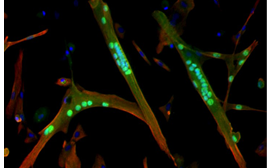
Stem Cell Environment and Skeletal Muscle Homeostasis

Skeletal muscle is a highly adaptable tissue with well-known sensitivities to environmental cues such as growth factors, cytokines, nutrients and mechanical loading. Moreover, adult skeletal muscle exhibits great plasticity and has the unique capacity to regenerate after injury, due to satellite cells, the muscle stem cells. Satellite cells, and their progeny, the myogenic precursor cells, must develop proper interactions with their direct environment to ensure muscle regeneration and replenishment of the stem cell pool. The aim of our research is to understand the role of the environment (non-myogenic cells and molecular structures) in the regulation of skeletal muscle regeneration. Myogenic cell environment includes inflammatory cells and particularly macrophages, vessel cells (endothelial and peri-endothelial cells) and interstitial cells. We aim at understanding the interactions between myogenic cells and their environment in various physiological and pathological situations.